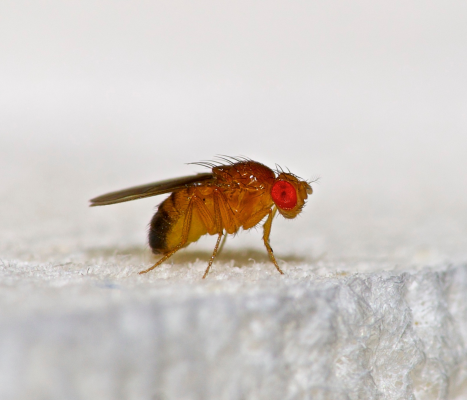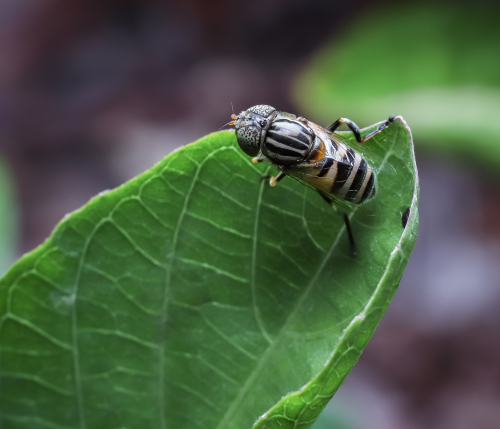Having little flying bugs in your home is frustrating. Unfortunately, telling them apart is not difficult when you don’t know what to look for.
Don’t worry. In this post, I am going to help you differentiate between fruit flies and grants and help you get rid of them.
Let’s dive in.
What Do Gnats Look Like?

Gnats are tiny winged insects that are dark brown. They are typically between ⅛ – ¼ inches long. Gnats can vary in color from light yellow, light brown to dark brown.
One key characteristic of gnats is their long legs. Their long legs often resemble those of a mosquito. Compared to other flies, their legs are easy to differentiate.
Certain species of gnats also have large abdomens and stinger. Gnats that have large abdomens and stingers are biting gnats. There are two types of gnats biting and non-biting gnats.
Non-biting gnats will not have large abdomens or stingers.
What Do Fruit Flies Look Like?

Furit flies are similar in size to gnats, they typically measure around ⅛ inch. One of their distinguishing features is that they have bright red eyes.
Another key characteristic of fruit flies is that they have stripes on their abdomens. Females tend to have more stripes than males. Females typically have 7 stripes while males tend to have 5 stripes.
What are the Main Differences Between Fruit Flies and Gnats?
If you are looking for key characteristics that will differentiate fruit flies and gnats there are a few things you can look for.
- Fruit flies have red eyes
- Gnats have long, mosquito like legs
- Fruit flies have stripes on their abdomens
- Biting gnats have stingers and large abdomens
What Causes Fruit Flies?
These flies need a source of water to survive. Source of water such as leaking faucets, pipes, broken sprinklers, or puddles of water can attract fruit flies and gnats.
It’s important to eliminate constant sources of moisture such as puddles or moist soil because this is where fruit flies will lay their eggs.
Likewise, you want to make sure you keep your garage cans covered and any fruits in an enclosed container.
Leaving these sources give fruit flies a location to lay their eggs and continue growing their population.
What Causes Gnats?
Moisture and food are two key elements that help sustain gnats. Many different elements will attract and maintain gnats.
Most gnats will survive on decaying organic matter. Gants are common in garbage cans, fruit or vegetables, gardens, moist soil, and decaying plants.
You want to make sure you reduce moisture around the outside of your home. Also, keep all trash cans covered to prevent gnats from gaining access to food.
You can also keep your yard well maintained and eliminate any decaying material that might be in your yard.
How To Get Rid of Gnats and Fruit Flies?
Weather you have fruit flies or gnats you can use the same methods to eliminate them from your home or yard.
1. Bug Zappers
Bug zappers are the most traditional method of eliminating flying insects both inside and outside your home.
These traps are best if they are used outside. When flies enter the trap, it can cause residual spray to enter the air. Keeping these outsides will keep bacteria and other residues outside of your home.
You can use bug zappers inside, but for sanitary purposes, they should be kept outside.
One common bug zapper used indoors is the handheld fly swatter. These are effective, but they can result in similar unsanitary conditions inside your home.
2. Bug/ Fly Traps
I highly recommend fly traps over bug zappers. Flytraps are a much more sanitary and effective method than bug zappers.
This is because fly traps use multiple lure methods to attract flying insects. Flytraps typically use UV lights, heat, and pheromones to attract flies.
This makes fly traps effective against gnats and fruit flies. Gnats are highly attracted to lights which makes the UV lights an effective lure. Likewise, the heat and pheromones will attract fruit flies.
Since both gnats and fruit flies are both not strong fliers, the vacuum method is highly effective.
The great thing about fly traps is that they are sanitary both indoors and outdoors. There are small fly traps perfect for indoors.
There are also larger fly traps specially designed to handle larger infestations.
3. Insecticide Spray
Insecticides sprays are also commonly used to eliminate fruit flies and gnats. These sprays are effective for two reasons.
First, you can spray insecticide sprays directly on any flies or gnats you encounter. Second, you can spray insecticide sprays on any surfaces that fruit flies or gnats frequent.
When they land on the surface, they will come in contact with the insecticide and eventually die.
It’s best to use all-natural options when spraying indoors. These options will keep the surfaces inside your home safe from any toxic chemicals.
When applying chemical insecticides outside, you don’t need to use natural options. It’s best to use chemicals that are safe for animals or gardens. These chemicals will allow you to apply them to your yard liberally, whereas other chemicals may be dangerous for edible plants or animals.
Below are some of the best insecticides that are also safe to apply on gardens or if you have pets.
4. DIY Trap
You don’t have to spend any money if you have gnats or fruit flies inside your house. You can use household items.
The easiest way to create a homemade trap is to use a bowl with a liquid inside. The liquid inside the bowl attracts gnats and fruit flies due to the moisture. When you combine with a moisture that will will the gnats or flies it becomes a very effective trap.
I recommend these combinations inside your DIY Trap:
- Dish Soap and Water
- Apple Cider Vinegar and Water
- Water and Honey
To enhance your combinations you can add rotting fruit to the inside. I prefer using apples or bananas including the peels and skins to attract gnats and fruit flies.
After mixing your desired combination I recommend covering your bowl with plastic wrap and pocking it with holes.
I find this method more effective at attracting flying insects and once they enter the whole in the plastic there is no way that they can exit.
5. Fly Paper
Fly paper is another common method used to eliminate gnats and fruit flies inside your home.
I recommend that you avoid using fly paper. These papers are unsanitary and unsightly when they are inside or outside.
A much more effective and safer alternative is using fly traps.
Fly traps are vacuum powered traps that will suck in any flies that fly near the trap.
The benefit with electric fly traps is that you can store them and use them during fly season. Fly paper you will need to throw away and purchase new ones every season. They are also not as effective at attracting gnats or fruit flies compared to electric fly traps.
How To Prevent Fruit Flies and Gnats?
The best way to prevent fruit flies and gnats is a two-step process. You need to take steps indoors and outdoors, depending on where the infestations are.
1. Keep Trash Can’s Covered
An important step to preventing gnats and flies inside your home is ensuring that your garbage is covered.
You should ensure that your indoor garbage is covered.
Trash is a perfect breeding ground for gnats and fruit flies. Trash provides gnats and fruit flies with moisture and food.
It’s also vital that you keep your garbage cans covered outdoors as well. This is quite easy because as long as you keep all your garbage cans closed and all trash inside.
2. Eliminate Moisture
Eliminating moisture is crucial to getting rid of gnats and fruit flies. Moisture helps them survive, and it also creates an ideal location for them to lay their eggs.
Indoors you want to make sure that you don’t have any leaking faucets or pipes anywhere in your home.
Another common source of moisture is indoor plants. Indoor plants can accumulate water, and gnats and fruit flies can live off these sources of water.
Outdoors you want to make sure that all your water is draining correctly. A common moisture issue is leaking or broken gutters and downspouts.
It’s important that you make sure your ground is leveled and you make sure that there are no puddles of water accumulating around your home.
You also want to make sure there are no leaks in your leaky pipes or leaking sprinklers. These will create moist areas around your yard that gnats can lay their eggs.
3. Keep your Yard Maintained
Keeping your yard well maintained is essential to eliminate potential hiding spots for gnats and fruit flies.
Gnats and fruit flies can hide and lay their eggs in piles of leaves, mulch, or grass clippings.
Eliminating any unnecessary items around your yard will help drive gnat and fruit flies away since there are no locations to lay their eggs.
4. Clean Food and Water around your home
Indoors you want to make sure you throw away or store all food properly. Avoid leaving any food or fruit outside for prolonged periods.
Food creates a source of moisture and a location that gnats and fruit flies can lay their eggs.
Keeping your house clean will drive gnats and fruit flies away. It will also help reduce the population that is currently living inside your home.
